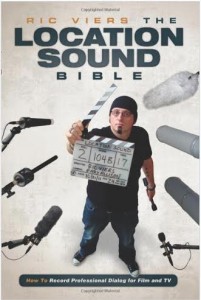Most video or film people will tell you it is usually a project to get good audio when out in the field. Out in the field means NOT in a studio. In a studio you have greater control of what you are recording but out in the field you have lots of things to contend with such a animal sounds, airplanes, cars and people. These elements can make getting that news sound bite or interview with the star of a film a very difficult proposition but with a little know-how and the right equipment you can get professional sound in just about any field application.
Ric Viers who authored “The Sound Effects Bible” now has another book called “The Location Sound Bible – How to Record Professional Dialog in Film and TV”. The book covers a lot of ground. He explains the many different microphones available and discusses the different pick-up patterns. You will now know which mic is best for the field recording you are doing. Should the mic be on a boom, a stand, hand-held or hidden in plant? It is all covered early on in the book
I’ve used a boom mic for several years on the indie films I work on and I was actually surprised to learn some terms for the various movements of a boom mic such as “follow”, “swing” and “cue”. It surprised me because I never even knew there was proper terminology for the use of a boom mic and now I among the informed. I will probably use this information on the next film I work on. People will think I’m either really smart or really annoying and nerdy. It’s the little things in life that excite me.
Around the middle of the book there is a section on using a slate on a film. I found that very informative as I sometimes think people just use a slate because it looks cool as opposed to actually using it to help sync audio. Viers also goes into using a sound report which is a sheet of paper to track the audio for the editor. You mark what is good, what is bad and any other bits of information that may be useful in post. Good stuff. I really learned quite a lot.
As in Viers other book he teaches you how to create a sound package of equipment on various budgets, only this time for field recording. Good information on set etiquette is included and can be applied to anyone, not just sound people. Also discussed is getting work in the business. How much to charge and places you can start looking to find work in the industry.
Viers gives us the one-two punch with his “Sound Effects Bible” and now his “Location Sound Bible”. A must read for anyone who wants to be in the business of capturing sound in the field or any filmmaker who wants to know how to improve the quality of their movie. I recommend getting both books for your reference library.
Rating: 8/10 – “Quiet on the set!”
